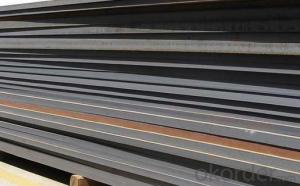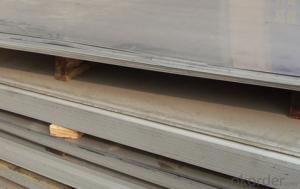Mild Carbon Steel Sheets 20G CNBM
- Loading Port:
- Qingdao
- Payment Terms:
- TT OR LC
- Min Order Qty:
- 10 pc
- Supply Capability:
- 30 pc/month
OKorder Service Pledge
OKorder Financial Service
You Might Also Like
Quick Details
| Grade: | 300 Series | Standard: | JIS, AISI, ASTM, DIN, EN | Length: | 1000-6000 |
| Thickness: | 0.5-100mm | Width: | 1000-2000 | ) | |
| Brand Name: | putan | Model Number: | Q235.Q345 | Type: | Plate |
| Application: | Construction plate,boiler plate,container plate,shipbuilding plate,all | Certification: | BV | type: | plate |
Packaging & Delivery
| Packaging Details: | Export standard package,bundled or be required. The inner size of container is below: 20ft GP: 5.8m(length) x 2.13m(width) x 2.18m(high) 25tons about 24-26CBM 40ft GP: 11.8m(length) x 2.13m(width) x 2.18m(high) 25tons about 54CBM 40ft HG: 11.8m(length) x 2.13m(width) x 2.72m(high) 25tons about 68CBM |
| Delivery Detail: | 7-15 days after receiving the deposit |
Specifications
Q235 Carbon sheet
Original :China
thickness 0.5mm~100mm,
coil steel Processing.
MOQ : 25TON
Carbon Steel plate
Product | SS400 carbon steel plate price |
Standard |
GB/T700-2006,ASTMA283/A283M-03,ASTMA572/A572M,JISG3101-2004,SS400, JIS G3135-1986,SPEC590,EN10025/2-2004,S235JR or S235J2,E335 or S335JR…
|
Width | 500-2000mm |
WT | 0.5 –60mm |
length | 2000—6000mm |
Applications range |
Construction plate,boiler plate,container plate,shipbuilding plate,all kinds of industries and manufacturing structural applications.
|
MOQ | 25 ton / according to customers' requirement |
Quality | good attestation of honour choosed by customers SGS |
Supply capability | 5,000 ton / month |
Key to success | advanced technique and service and low price |
Authentification | ISO9001:2008 |
Market | North/South America, Europe, Asia,Africa,Mid East,ect. |
Packaging |
Standard seaworthy packing / according to the customers’requirement
|
Port | |
Delivery term |
T/T,L/C 30% deposit the balance before shipment,the balance paid by the copy of B/L OR L/C at sight
|
Delivery time | In 15 – 45 days after contract |
- Q:Can steel sheets be used for making shipping containers?
- Yes, steel sheets can be used for making shipping containers. In fact, steel is the most commonly used material for constructing shipping containers due to its strength, durability, and resistance to various weather conditions and environmental factors. Steel sheets are typically cut, bent, and welded together to form the walls, roof, and floor of the container. This construction method ensures that the shipping container is sturdy and capable of withstanding the rigors of transportation, including stacking, lifting, and exposure to harsh marine environments. Additionally, steel containers are easily customizable and can be modified to meet specific requirements for cargo storage and transportation.
- Q:What is called steel plate sanding process?
- Steel plate sand, we call sandblasting, sandblasting is the steel structure of the steel plate surface treatment.
- Q:How are steel sheets protected during shipping?
- To guarantee the secure delivery of steel sheets, numerous measures are taken to protect them during shipping. One commonly used technique involves using packaging materials like cardboard or wooden crates, specifically designed to securely hold the steel sheets in place and reduce the risk of movement or potential damage during transit. Furthermore, steel sheets may also be shielded from moisture, dust, and other environmental factors by applying a protective coating or wrap. This can take the form of a thin layer of oil, wax, or a specialized rust inhibitor, acting as a barrier against corrosion. To enhance protection even further, steel sheets are often stacked and fastened with strapping or banding materials. These measures ensure that the sheets remain in a fixed position and do not shift during transportation, preventing any potential impact or friction that could cause damage. Additionally, shipping companies implement special handling procedures to minimize the risk of harm. This involves utilizing equipment such as forklifts or cranes to carefully load and unload the steel sheets, avoiding any rough handling or accidental drops that could result in dents or bends. In conclusion, a combination of appropriate packaging, protective coatings, secure strapping, and careful handling guarantees the adequate protection of steel sheets during shipping. This comprehensive approach minimizes the possibility of any damage occurring and ensures that the sheets arrive in optimal condition at their intended destination.
- Q:What are the different grades of steel sheets available?
- There are several different grades of steel sheets available, including mild steel, stainless steel, galvanized steel, high-strength low-alloy (HSLA) steel, and carbon steel. Each grade has unique properties and is suitable for various applications in industries such as construction, automotive, and manufacturing.
- Q:What are the different fastening options for steel sheets?
- There are several fastening options available for steel sheets, depending on the specific application and requirements. Some common fastening options for steel sheets include: 1. Screws: Steel sheets can be fastened using screws, which are readily available and easy to use. Self-tapping screws are commonly used for fastening steel sheets, as they can create their own threads in the material. 2. Bolts and nuts: Bolts and nuts provide a strong and secure fastening option for steel sheets. They are commonly used in applications where the fastening needs to be adjustable or removable. 3. Rivets: Rivets are permanent fasteners that are commonly used to join two or more steel sheets together. They are often used in applications where a watertight or airtight seal is required. 4. Welding: Welding is a commonly used method for fastening steel sheets. It involves melting the edges of the sheets and fusing them together. Welding provides a strong and durable connection but requires specialized equipment and expertise. 5. Adhesives: Certain adhesives, such as epoxy or structural adhesives, can be used to bond steel sheets together. Adhesives can provide a clean and aesthetically pleasing connection, but their strength may vary depending on the specific adhesive used. 6. Clips and clamps: Clips and clamps are often used to secure steel sheets in place. They can be easily installed and removed, making them a popular choice for temporary or adjustable fastening needs. 7. Magnetic fasteners: Magnetic fasteners, such as magnetic strips or magnets with hooks, can be used to attach steel sheets to magnetic surfaces. This provides a convenient and easy-to-use fastening option. It is important to consider factors such as strength, durability, ease of installation, and removal when selecting a fastening option for steel sheets. The specific requirements of the application, such as load-bearing capacity and environmental conditions, should also be taken into account to ensure the chosen fastening option is suitable for the intended purpose.
- Q:What are the standard sizes of steel sheets?
- The standard sizes of steel sheets vary, but some common dimensions include 4x8 feet, 4x10 feet, and 5x10 feet.
- Q:What is the difference between a HRPO and HRSPO steel sheet?
- The main difference between a HRPO (Hot Rolled Pickled and Oiled) and HRSPO (Hot Rolled Skin Pass) steel sheet lies in the manufacturing process and the resulting properties of the two types of sheets. HRPO steel sheets are produced by hot rolling a steel slab and then subjecting it to a pickling process where the surface scale is removed using an acid bath. After pickling, the steel sheet is then oiled to provide a protective coating. The pickling process imparts a clean, smooth surface to the sheet, while the oiling helps prevent corrosion and improve formability. HRPO sheets are typically used in applications that require good surface finish and paintability. On the other hand, HRSPO steel sheets undergo an additional skin pass rolling process after pickling and oiling. This process involves passing the sheet through a set of rolls to further improve its surface quality, resulting in a smoother and more uniform surface finish compared to HRPO sheets. The skin pass process also imparts better flatness and dimensional accuracy to the sheet. HRSPO sheets are commonly used in applications that demand higher surface quality, such as automotive panels, appliances, and electrical enclosures. In summary, while both HRPO and HRSPO steel sheets are pickled and oiled, the additional skin pass rolling step in the manufacturing process of HRSPO sheets enhances their surface quality, flatness, and dimensional accuracy, making them suitable for more demanding applications.
- Q:What are the different types of steel sheet finishes?
- Various purposes are served by several different types of steel sheet finishes, each providing unique aesthetics. Some common types include: 1. Hot Rolled: Achieved by heating the steel sheet above its recrystallization temperature and rolling it to the desired thickness. It has a rough and textured surface, suitable for applications where appearance is not a priority. 2. Cold Rolled: After hot rolling, the steel sheet is passed through rollers at room temperature to achieve a smooth and polished finish. Cold rolled finishes are often used in applications that require a superior surface finish, such as automotive panels or appliances. 3. Galvanized: In this process, the steel sheet is coated with a layer of zinc to provide corrosion resistance. The zinc coating also gives the sheet a shiny and reflective appearance. Galvanized finishes are commonly used in outdoor applications to protect against rust and harsh weather conditions. 4. Stainless Steel: Achieved by adding chromium to the steel sheet, providing excellent corrosion resistance and a sleek, reflective surface. Stainless steel finishes are widely used in kitchen appliances, architectural applications, and medical equipment, where hygiene and durability are essential. 5. Coated Finishes: Steel sheets can be coated with various materials, like paint, epoxy, or polymer, to enhance appearance or provide additional protection. Coated finishes can be customized to meet specific requirements, such as color or texture, and are often used in architectural and decorative applications. 6. Brushed: Obtained by brushing the steel sheet with abrasive material, creating a textured and matte surface. Brushed finishes are commonly used in interior design and furniture manufacturing, where a contemporary and stylish appearance is desired. These examples represent just a few of the available steel sheet finishes. The choice of finish depends on the specific requirements of the application, such as corrosion resistance, aesthetic appeal, or surface texture.
- Q:Can steel sheets be used for manufacturing shipping containers?
- Yes, steel sheets can be used for manufacturing shipping containers. Steel is a durable and strong material that provides excellent structural integrity, making it ideal for constructing shipping containers. Steel sheets are typically used to create the walls, roof, and floor of the container, ensuring the container can withstand the rigors of transportation and protect the goods inside. Additionally, steel is resistant to various weather conditions, corrosion, and pests, making it a reliable choice for shipping container manufacturing.
- Q:What does steel plate "A3" mean?
- It can be used in all kinds of grinding tools, handles and other unimportant Abrasives parts
1. Manufacturer Overview |
|
|---|---|
| Location | |
| Year Established | |
| Annual Output Value | |
| Main Markets | |
| Company Certifications | |
2. Manufacturer Certificates |
|
|---|---|
| a) Certification Name | |
| Range | |
| Reference | |
| Validity Period | |
3. Manufacturer Capability |
|
|---|---|
| a)Trade Capacity | |
| Nearest Port | |
| Export Percentage | |
| No.of Employees in Trade Department | |
| Language Spoken: | |
| b)Factory Information | |
| Factory Size: | |
| No. of Production Lines | |
| Contract Manufacturing | |
| Product Price Range | |
Send your message to us
Mild Carbon Steel Sheets 20G CNBM
- Loading Port:
- Qingdao
- Payment Terms:
- TT OR LC
- Min Order Qty:
- 10 pc
- Supply Capability:
- 30 pc/month
OKorder Service Pledge
OKorder Financial Service
Similar products
New products
Hot products
Related keywords






























